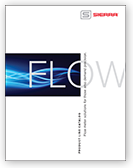Official Blog of Sierra--Let's Talk Flow!
Bringing Energy Efficiency and Cost Savings to Veteran’s Facilities
As the infrastructure of our Veterans Affairs (VA) facilities age and government-driven energy efficiency mandates rise, VA facilities’ engineers are faced with a decision to upgrade existing equipment or replace older equipment in order to improve energy efficiency. Dealing with the upgrade or replace decision is a big one. Replacing older equipment is costly, but in the end, newer technology may integrate better into automation systems and realize even greater cost saving in energy over the long haul. What kind of data do facilities managers need to make these critical energy-saving decisions?
The Best Place To Start-Ask the Right Questions
A great place to start is by getting accurate “flow energy” measurements of the methane/natural gas, water, and steam flow in your major operations, especially in boilers and steam flow systems. Flow energy is defined as “flows that cost money,” like natural gas, compressed air, water, and steam. Since none of these commodities are “free,” VA facilities managers must strive to measure their “energy” usage accurately, determine the processes that use the most energy, and make them more efficient either by upgrading or replacing the equipment.
- Is your boiler running at optimal levels?
To assess the efficiency of your boiler’s combustion, it’s critical to get accurate inlet methane measurements. Once you have accurate methane measurements, you can answer the key question: Is my boiler running too rich or too lean? If your boiler is running “rich”, which means it is using more methane than is needed for optimal combustion, you not only waste money on natural gas costs but also emit more hazardous air pollutants into our environment-every molecule of methane that is not burned increases emissions. If you’re running too “lean”, your boiler is not at optimal combustion, so you are not producing steam at capacity. Once you have determined the health of your boiler, you can either make the decision to replace your aging boiler or use measurements from thermal mass flow meters to better tune your current boiler. Learn More about Boiler Efficiency. - How much steam are your boilers producing? How much steam are you allocating?
Efficient steam production is critical for optimizing energy at Veteran Affairs facilities. The steam produced by a boiler must be measured in order to determine boiler efficiency. Accurate steam flow measurements at the production point and key allocation points will give you a true assessment of how efficient steam is running through the facility and helps identify leaks in the system. Now the question becomes what technology provides the most accurate steam flow measurement? Traditionally, steam flow has been measured with a differential pressure device. This is typically an orifice plate. However, such devices are inherently volumetric flow measurements. Changes in pressure and temperature will change the mass flow rate of steam. Even a “small” change of 10 percent in steam pressure will result in a 10 percent error in non-compensated mass flow. This means that, in a typical differential pressure measurement installation, the volumetric flow rate measured by the device must be compensated by measuring temperature and pressure, and then these three measurements (ΔP, T and P) integrated with a flow computer to calculate mass flow.
Insertion multivariable vortex flow meters allow one instrument and one process connection to simultaneously measure mass flow rate, temperature, pressure, volumetric flow rate, and fluid density. The density of saturated steam varies with either temperature or pressure, while superheated steam varies with temperature and pressure, so multivariable vortex flow meters assure the flow meter’s density calculations are correct, and therefore, mass steam flow measurements are correct maximizing your steam productivity. Multivariable vortex flow meters provide steam accuracy of 1 percent of reading, 30:1 turndown plus pressure and temperature compensation.Again, you may need to upgrade aging steam flow infrastructure or simply tune your system with accurate steam flow measurement to save on cost and fulfill efficiency mandates. - How much water are you using for key processes?
In boiler tuning, the feedwater flow to the boiler is an important measurement, since you need to measure the efficiency at which the boiler turns this feed water into steam. You may also need to measure the thermal/BTU energy. A clamp-on ultrasonic flow meter is ideal for this type of water measurement due to high accuracy at low and high flows, installation with no pipe cutting or process shutdown, and immunity to external noise. Coupled with temperature sensors on the “hot” and “cold” legs, the thermal energy gained or lost can be measured. This thermal/BTU measurement is critical for optimizing central heating and cooling systems that provide HVAC to the entire facility.
Big-3 Eases the Burden of Recommissioning
To address the flow measurement of the methane, steam, and water for such a large scale equipment upgrade, Veteran Affairs facility managers would typically work with up to 5 different companies with varying technologies to get these critical flow energy measurements. Imagine only working with one supplier for all of your gas, liquid and steam flow measurements. Sierra provides flow experts and Big-3 technology for all gas, liquid, and steam flow measurements. The Big-3 includes:
- QuadraTherm 640i/780i, the most accurate thermal flow meters on the market for methane and air flow measurement
- Insertion mulitvariable InnovaMass 240i/241i vortex flow meters for steam flow measurements-easy hot tap installation
- Clamp on InnovaSonic 207i ultrasonic water flow meters with energy/BTU capability
- Specialized, local support team for all three technologies
- Shared software applications and operating system for easy integration
- Designed, built, and calibrated in the USA by Sierra
Learn more about Flow Energy Measurement of All gas, liquid, steam flow.
Watch Flow Energy Management Videos
Scott Rouse, Product Line Director
Sierra Instruments

 Go to Autotest Division >
Go to Autotest Division > DOWNLOAD
DOWNLOAD